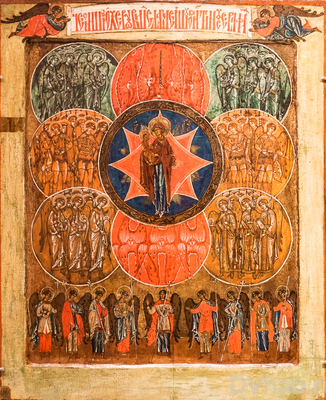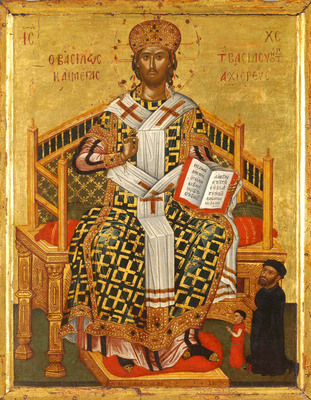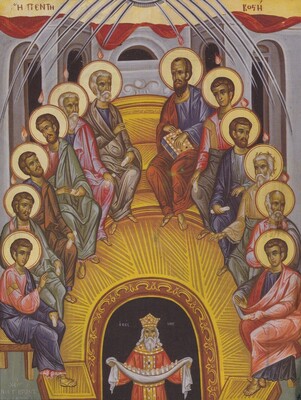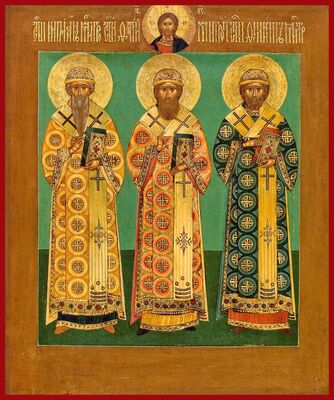Table of Contents
Scripture

| Old Testament | New Testament |
|---|---|
| Genesis | Matthew |
| Exodus | Mark |
| Leviticus | Luke |
| Numbers | John |
| Deuteronomy | Acts |
| Joshua | James |
| Judges-Ruth | 1 Peter |
| 1-2 Kings | 2 Peter |
| 3-4 Kings | 1 John |
| 1-2 Chronicles | 2 John |
| 1-2 Esdras | 3 John |
| Esther | Jude |
| (1 Maccabees) | Romans |
| (2 Maccabees) | 1 Corinthians |
| (3 Maccabees) | 2 Corinthians |
| Job | Galations |
| Psalms | Ephesians |
| Proverbs | Philippians |
| Ecclesiastes | Colossians |
| Song of Songs | 1 Thessalonians |
| (Wisdom) | 2 Thessalonians |
| (Sirach) | 1 Timothy |
| The Twelve | 2 Timothy |
| Esaias | Titus |
| Jeremias | Philemon |
| Ezechiel | Hebrews |
| Daniel | (Apocalypse) |
-
The twelve minor Prophets are: j. Osee, ij. Amos, iij. Michæas, iv. Joel, v. Abdias, vi. Jonas, vij. Naum, viij. Abacuc, ix. Sophonias, x. Aggæus, xi. Zacharias, & xij. Malachias.
-
The Prayer of Manasses is appended to 2 Chronicles.
-
Nehemias is appaneded to 2 Esdras. Regarding the counting of Esdras:
| Septuagint | Vulgate | Masoretic |
|---|---|---|
| 1 Esdras | 3 Esdras | — |
| 2 Esdras | 1-2 Esdras | Esdras-Nehemias |
| 3 Esdras | 4 Esdras | — |
-
Judith & Tobit are appended to Esther.
-
Baruch & Lamenations, with the Epistle of Jeremias are, appended to Jeremias.
-
Susanna is prepended to Daniel, the Prayer of the Three Youths is kept in, and Bel & the Serpent is appended.
-
The Psalms are 151 in number.
The text types received & passed down by the Church are: for the Old Testament, the Septuagint (save for Theodotion’s Daniel), for the New Testament, the Majority Text.
The only available English translations of these are: Lancelot Brenton’s Septuagint, & the King James Version’s New Testament—with a few errors. All others are based on corrupted Jewish texts for the Old Testament & miscopies from dung-hills for the New Testament. More on Bible translations.
See where the New Testament affirms the Septuagint against Hebrew corruption.
Further, these were passed down in appendices & are beneficial, but are not Sacred Scripture:
| Old Testament | New Testament |
|---|---|
| 4 Maccabees | Didache |
| 3 Esdras | Shepherd of Hermas |
| 1 Clement | |
| 2 Clement |
Angels

The Bodiless Powers are ordered into a triad of triads:
| Hierarchy | Rank | Greek | Hebrew |
|---|---|---|---|
| Highest | Seraphim | seraphī́m | seraphim |
| Cherubim | cherubī́m | cherubim, chaiot | |
| Thrones | thrónœ | ophanim, erelim | |
| Middle | Powers | exusíes | — |
| Dominions | cyriótētes | chasmallim | |
| Principalities | archés | — | |
| Lowest | Virtues | dynámīs | malacim |
| Archangels | archángelœ | — | |
| Angels | ángelœ | — |
The seven named Archangels:
| Archangel | Name Meaning |
|---|---|
| Michael | Who is like God? |
| Gabriel | Man of God |
| Raphael | Healing of God |
| Uriel | Fire of God |
| Barachiel | Blessing of God |
| Salathiel | Prayer of God |
| Jegudiel | Glory of God |
| (Jeremiel) | (Raising of God) |
Despite their name, the seven Archangels are ranked as Seraphim. An additional archangel, here in parenthesis, is sometimes added.
The first four of the seven Archangels are who stand in the corners of the chariot (mercabah) of God, watched over the camps of Israel in the wilderness, & are set over the winds.
Church

| Old Testament | New Testament |
|---|---|
| Ark of the Covenant | Altar Table |
| Pot of Manna | Reserved Gifts |
| Aaron’s Rod | The Lord’s Cross |
| Tables of Testimony | Gospel Books |
| The Temple | The Church |
| Holy of Holies | Altar |
| Holies | Nave |
| Court | Narthex |
| Aaronic Order | Melchisedecian Order |
| High Priest | Bishop |
| Priests | Priests |
| Levites | Deacons |
| High Sabbaths | Great Feasts |
| — | The Nativity of the Theotokos |
| Day of Atonement(?) | The Exaltation of the Cross |
| — | The Entry of the Theotokos |
| Lights | The Nativity |
| Trumpets(?) | Theophany |
| Lots(?) | The Meeting of the Lord |
| — | The Annunciation |
| The Entry of the Lord | |
| Passover | Pascha |
| The Ascension | |
| Weeks | Pentecost |
| Tabernacles | The Transfiguration |
| — | The Dormition of the Theotokos |
In the King James Version, high priest is translated as chief priest, bishop as overseer, priest as elder, and deacon as servant or minister.
The Holy Mysteries of the Church are:
- Baptism
- Chrismation
- Communion
- Repentence
- Unction
- Matrimony
- Ordination
Repentence is more commonly called Confession. Some count more or less than these by considering some as parts of others—e.g. counting Baptism & Chrismation as one, &c.
The ranks of Saints are:
- Apostles
- Martyrs
- Prophets
- Hierarchs
- Monastics
- Righteous
The orders of clergy are:
- Episcopate
- Patriarch
- Archbishop
- Metropolitan
- Bishop
- Presbyterate
- Archpriest
- Protopriest
- Priest
- Diaconate
- Archdeacon
- Protodeacon
- Deacon
- Suborders
- Subdeacon
- Reader
The orders of monastics are:
- Great Schema
- Stavrophore
- Rassophore
- Novice
Further, their are two classes for the heads of monasteries:
- Archimandrite
- Hegumen
Councils

| Church | Primate |
|---|---|
| 🇮🇹 Rome | — |
| 🇹🇷 Constantinople | Patr. Bartholomew |
| 🇸🇾 Antioch | Patr. John X |
| 🇪🇬 Alexandria | PP. Theodorus II |
| 🇵🇸 Jerusalem | Patr. Theophilus III |
| 🇷🇺 Moscow | Patr. Cyril |
| 🇬🇪 Mtskheta-Tbilisi | Patr. Elias II |
| 🇷🇸 Peč | Patr. Porphyry |
| 🇷🇴 Bucharest | Patr. Daniel |
| 🇧🇬 Sofia | Patr. Daniel |
| 🇨🇾 New Justiana | Abp. Chrysostom II |
| 🇬🇷 Athens | Abp. Hieronymus II |
| 🇵🇱 Warsaw | Mtr. Sabba |
| 🇦🇱 Tirana | Abp. Anastasius |
| 🇸🇰 Prešov | Mtr. Rostislav |
| 🇲🇰 Skopje | Mtr. Stephan |
| 🇺🇸 Washington | Mtr. Tikhon |
| 🇪🇬 Sinai | Abp. Damian |
| 🇫🇮 Helsinki | Abp. Elias |
| 🇯🇵 Tokyo | Mtr. Seraphim |
| 🇺🇦 Kiev | Mtr. Onuphrius |
| 🇨🇳 Beijing | — |
| 🇰🇵 Korea | Mtr. Theophanes |
| 🇺🇸 Russian Church Abroad | Mtr. Nicholas |
| 🇧🇾 Minsk | Mtr. Benjamin |
| 🇲🇩 Kishinev | Mtr. Vladimir |
| 🇱🇻 Riga | Mtr. Alexander |
| 🇪🇪 Tallinn | Mtr. Eugene |
The first five (Rome–Jerusalem) are called the Ancient Patriarchates. The next (Moscow–Sofia) are called the Junior Patriarchates. The Patriarchates & the next seven (New Justiana–Skopje) are all autocephalous (i.e. self-headed).
From Sinai–Russian Church Abroad are autonomous (i.e. self-governing), Sinai being under Jerusalem, Helsinki under New Rome, & the rest under Moscow.
From Minsk–Tallinn are semi-autonomous, under Moscow.
The Holy Œcumenical Councils m are:
| Name | Year | Called By | Presided By |
|---|---|---|---|
| Nicæa I | 5834 AM | St. Constantine the Great | St. Hosius of Corduba |
| Constantinople I | 5890 AM | St. Theodosius the Great | St. Gregory the Theologian |
| Ephesus | 5940 AM | St. Theodosius the Younger | St. Cyril of Alexandria |
| Chalcedon | 5960 AM | St. Marcian the Emperor | St. Pope Leo the Great |
| Constantinople II | 6062 AM | St. Justninian the Great | St. Eutychius of Constantinople |
| Constantiniple III | 6189 AM | St. Constantine the New | St. George of Constantinople |
| Trullo | 6201 AM | Emperor Justinian the Slit-nosed | St. Paul the New |
| Nicæa II | 6296 AM | Empress Irene | St. Tarosius of Constantinople |
| Constantinople IV | 6388 AM | Emperor Basil the Macedonian | St. Photius the Great |
| Constantinople V | 6850 AM | Emperor John Cantacuzenus | Patr. Isidore I of Constantinople |
The principal figures whose theology is accepted or reject at each council are:
| Council | Canonized | Condemened |
|---|---|---|
| Nicæa I | St. Athanasius the Great | Arius of Alexandria |
| Constantinople I | St. Gregory the Theologian | Apollinaris of Laodicea |
| Eunomius Cyzicus | ||
| Ephesus | St. Cyril of Alexandria | Nestorius of Constantinople |
| Cælestius | ||
| Chalcedon | St. Flavian of Constantinople | Eutyches of Constantinople |
| St. Pope Leo the Great | Dioscorus of Alexandria | |
| Constantinople II | St. Justinian the Great | Theodore of Mopsuestia |
| Origin of Alexandria | ||
| Constantinople III | St. Maximus the Confessor | Sergius of Constantinople |
| Nicæa II | St. John of Damascus | Leo the Syrian |
| Constantinople IV | St. Photius the Great | Pope Nicholas |
| Constantinople V | St. Gregory Palamas | Barlaam of Calabria |
| Gregory Acidynus |
It should be known that Rome only presided over the I & IV Councils, & was absent from the II, III, VIII, & IX. Additionally, the VI Council condemns Pope Honorius as a heretic, which was confirmed by Pope Leo II. Rome originally accepted the VIII Council, under Pope John VIII, only retroactively rejecting it later.
Further, these local councils have been recieved by the whole Church, and are of particular importance:
| Name | Year | Presided |
|---|---|---|
| Jassy | 7151 AM | Patr. Parthenius of Constantinople |
| Jerusalem | 7181 AM | Patr. Dositheus Notaras of Jerusalem |
| Constantinople | 7381 AM | Patr. Anthimus VI of Constantinople |
And again, those principal figures accepted or rejected:
| Council | Canonized | Condemned |
|---|---|---|
| Jassy | St. Peter Mogila | Lutheranism |
| Jerusalem | Patr. Dositheus Notaras of Jerusalem | Calvinism |
| Constantinople | — | Hilarion of Macariopolis |
Liturgics

| Service | Time |
|---|---|
| Vespers | 6PM |
| Compline | 9PM |
| Midnight Office | 12AM |
| Matins | 3AM |
| First Hour | 6AM |
| Third Hour | 9AM |
| Sixth Hour | 12PM |
| Ninth Hour | 3PM |
The Divine Liturgy is mystically outside the daily cycle, but is usually celebrated after the Sixth Hour.
The liturgical tradition of the Church was standardized by the Great Lavra of St. Sabbas in Jerusalem, Palestine, which was founded in 5987 AM. It was restandardized for civil use by St. Theodore (†6335 AM) at the Studion Monastery, Constantinople.
The contemporary differences between the Greeks & the Slavs comes from a Greek reform in 7347 AM, & a revision of it in 7397 AM by Protopsaltes George Biolaces. More details about the differences.
Book of the Gospels, j. volume. Contains the Scripture readings from the canonical Gospels.
Book of the Apostles, j. volume. Contains the Scripture readings from the canonical Book of Acts & Epistles, but not the Apocalypse.
Book of the Prophets, j. volume. Contains the Scripture readings from the Septuagint, but not the Psalms.
Book of Psalms, j. volume. Contains the canonical Psalms & Odes from the Septuagint.
Book of the Hours, j. volume. Contains the unmoving portions of the hourly services.
Book of the Eight Tones, viij. volumes. Contains the moving portions for each tone of the week.
Book of the Months, xij. volumes. Contains the moving portions for each commemoration of the day.
Book of the Three Odes, j. volume. Contains the moving portions for each day of Great Lent & Holy Week.
Also called the Pentecostarian, or Book of the Fifty Days, j. volume. Contains the moving portions for each day of Pascha & Pentecost.
Books of the Synaxis, xij. volumes. Contains readings of the lives of the Saints.
Contains a list of the commemorations for each day.
Hebrew
| Hebrew | Latin | Meaning |
|---|---|---|
| יְהוָה | Iahweh | The Existing |
| אל | El | God |
| אלהים | Elohim | God |
| אֵל שַׁדַּי | Saddai | Almighty |
| אֲדֹנָי | Adonai | My Lord |
| צבאות | Sabaoth | Hosts |
| מַלְאַךְ | Malac | Angel |
| מימרא | Memra | Word (cf. Lógos) |
| שְׁכִינָה | Shecinah | Pressence |
| מֶרְכָּבָה | Mercabah | Chariot |
| שָׁבַת֙ | Sabbath | Cease |
| הללויה | Alleluia | Praise the Lord |
| אָמֵן | Amen | Verily |
| הוֹשִׁיעָה נָּא | Hosanna | Save us, we pray |
| תּוֹרָה | Torah | Pentateuch |
| נְבִיאִים | Nebi’im | Prophets |
| כְּתוּבִים | Cetubim | Writings |
The Tetragrammaton (Iahweh) is usually translated & read as Lord.
Bible Study
| KJV | Name | Meaning |
|---|---|---|
| — | Adam | Red earth |
| — | Eve | Life |
| — | Abel | Pasture |
| — | Cain | Having |
| — | Enoch | Dedicated |
| — | Noah | Wandering |
| Nimrod | Nebrod | Hunter |
| — | Abraham | Father of multitudes |
| — | Lot | Veil |
| — | Sara | Princess |
| — | Sodom | Burning |
| — | Gomorrha | Rebellious people |
| — | Melchisedec | King of righteousness |
| — | Isaac | To smile |
| — | Jacob | Heel |
| — | Israel | Seeing God |
| — | Moses | Saved from water |
| — | Aaron | Light |
| Joshua | Jesus | The Lord saves |
| — | Debora | Bee |
| — | Gideon | He who cuts off (iniquity) |
| — | Samson | Like the sun |
| Dalila | Dalida | Delicate |
| — | David | Beloved |
| — | Anna | Gracious |
| — | Solomon | Peaceful |
| Elijah | Elias | My God is the Lord |
| Elisha | Eliseus | Whom God is salvation |
| Isaiah | Esaias | Salvation of the Lord |
| — | Jeremias | Appointed by the Lord |
| — | Ezechiel | Strengthened by God |
| — | Susanna | Lily |
| — | Daniel | Judge of God |
| — | Azarias | The Lord helps |
| — | Abednego | Servant of light |
| Hosea | Osee | Salvation |
| — | Zacharias | Remembered by the Lord |
| — | Malachias | Messenger of the Lord |
| — | Matthew | Gift of the Lord |
| — | Mark | Shining |
| — | Luke | Light |
| — | John | The Lord is gracious |
| — | Elizabeth | Whom God has promised |
| — | Mary | Drop of the sea |
| — | Zebedee | Gift of the Lord |
| — | Simon | Who listens |
| — | Peter | Rock |
| — | Cephas | cf. Peter |
| — | James | cf. Jacob |
| — | Nathanael | Gift of God |
| — | Thomas | Twin |
| — | Didymus | cf. Thomas |
| — | Zacchæus | Pure |
| — | Martha | Lady |
| — | Lazarus | Whom God helps |
| — | Jairus | The Lord enlightens |
| — | Barrabas | Son of (the) father |
| — | Saul | Asked for |
| — | Paul | Small |
| — | Eden | Pleasantness |
| — | Euphrates | Fertile river |
| — | Jerusalem | City of peace |
| — | Mamre | Fatness |
| — | Chebron | Alliance |
| — | Bethel | House of God |
| — | Bethlehem | House of bread |
| — | Arabia | Desert |
| — | Sinai | Pointed |
| — | Tabor | Height |
| — | Jordan | Flowing down |
| — | Canaan | Lowland |
| — | Jericho | Fragrant place |
| — | Sidon | Fishing |
| — | Ærmon | Lofty |
| — | Tyre | Rock |
| — | Zion | Raised up |
| — | Lebanon | White mountain |
| — | Gaza | Fortified place |
| — | Palestine | Land of strangers |
| — | Samaria | Guard |
| — | Ethiopia | Blackness |
| — | Cedron | Turbid |
| — | Arimathea | High place |
| — | Nazareth | Separated |
| — | Galilee | Circuit |
| — | Bethsaida | House of fishing |
| — | Bethany | House of dates |
| — | Bethesda | House of mercy |
| — | Capernaum | City of consulation |
| — | Emmaus | Hot springs |
| — | Gethsemane | Oil press |
| — | Calvary | Skull |
| — | Golgotha | cf. Calvary |
| — | Armageddon | High place with troops |
St. Matthew’s gospel, symbolized by the man of the Cherubim, represents the Lord as humble Prophet. St. Mark’s, symbolized by the lion, represents Him as conquering King. St. Luke’s, the ox, represents Him as great High-Priest. St. John’s, the eagle, as God Most-High.
- Old Testament
- Genesis
- 1:5 – The Angels were created either on the 1st or 5th day.
- Exodus
- 3:14 – THE BEING, ho ṓn, i.e. the Existing.
- 25:9 – the pattern, tò parádīgma, i.e. the form.
- 26:30 – the fashion, tò eîdos, cf. Exo. 25:9.
- Genesis
- New Testament
- Matthew
- 1:16 – of whom, is feminine.
- 6:11 – daily, epiúsion, i.e. supra-substantial.
- 6:13 – evil, should read, the evil one.
- 14:27 – it is I, egṓ eími, no implied predicate, therefore, ho ṓn, cf. Exo. 3:14.
- 18:2 – a little child, i.e. St. Ignatius Theophorus.
- 27:54 – the centurion, i.e. St. Loginus.
- Mark
- 1:1 – gospel, euangelíu, good news, used of a triumph (cf. Julias Cæsar).
- 6:50 – cf. Mat. 14:27.
- 25:39 – cf. Mat. 27:54
- Luke
- 3:23-38 – Joseph’s adoptive lineage, cf. Mat. 1:2-16.
- 11:3 – cf. Mat. 6:11.
- 23:40 – the other, i.e. St. Dismas.
- John
- 1:4 – cf. Exo. 3:2;13:21, Esa. 6:1-5.
- 8:24,58 – cf. Mat. 14:27.
- 10:35 – the Word, i.e. the Lord.
- 14:2 – house, i.e. tent.
- 14:2 – mansions, i.e. partitions.
- 19:14 – The evening before was an early Pascha meal.
- 21:15 – love me, ágapâs me; love you, philō̂ se.
- 21:17 – love me, philī̂s me.
- Acts
- 17:30 – winked act, archaicism, read as if ignored.
- 20:13 – fetched a compass, archaicism, read as if turned back.
- 1 Corinthians
- 11:14 – long hair, i.e. referring to styling.
- Galatians
- 1:8 – accursed, anáthema.
- Ephesians
- 1:19 – working, enérgīan.
- 3:7 – effectual working, cf. Eph. 1:19.
- 4:16 – cf. Eph. 3:7.
- 3:21 – cf. Eph. 1:19.
- Colossians
- 1:29 – cf. Eph. 1:19.
- 2:12 – operation, cf. Eph. 1:19.
- 1 Peter
- 5:13 – Marcus, i.e. St. Mark the Evangelist.
- Matthew
References
- John of Damascus, St. “An Exact Exposition of the Orthodox Faith” in: The Fount of Knowledge.
- Epiphanius of Salamis, St. On Weights and Measures.
- Nicodemus the Hagiorite, St; Macarius of Corinth, St. The Philocalia.